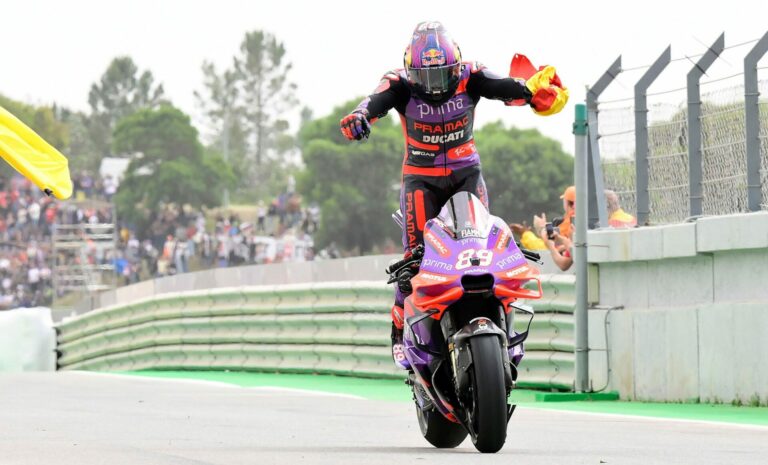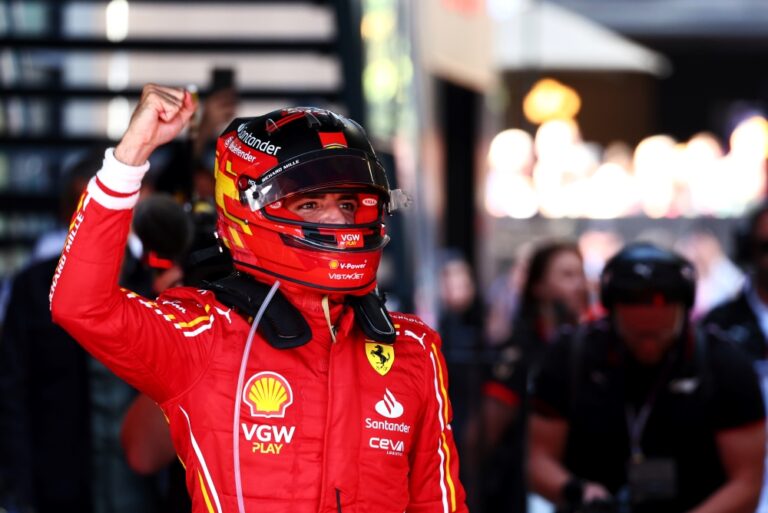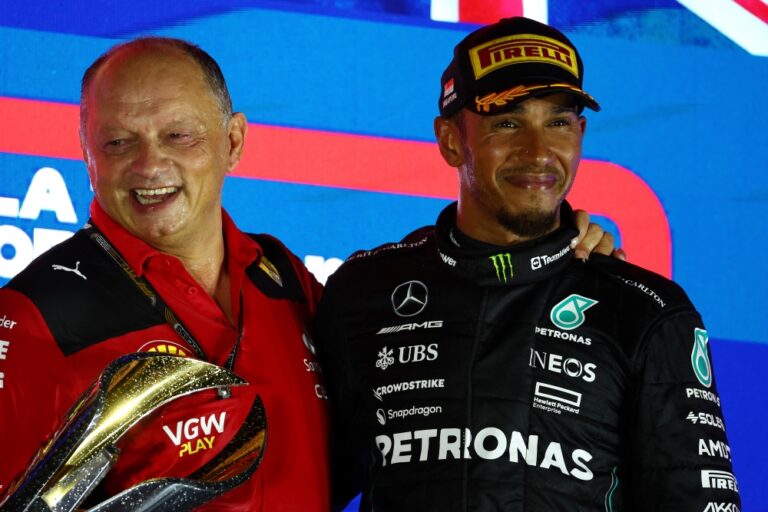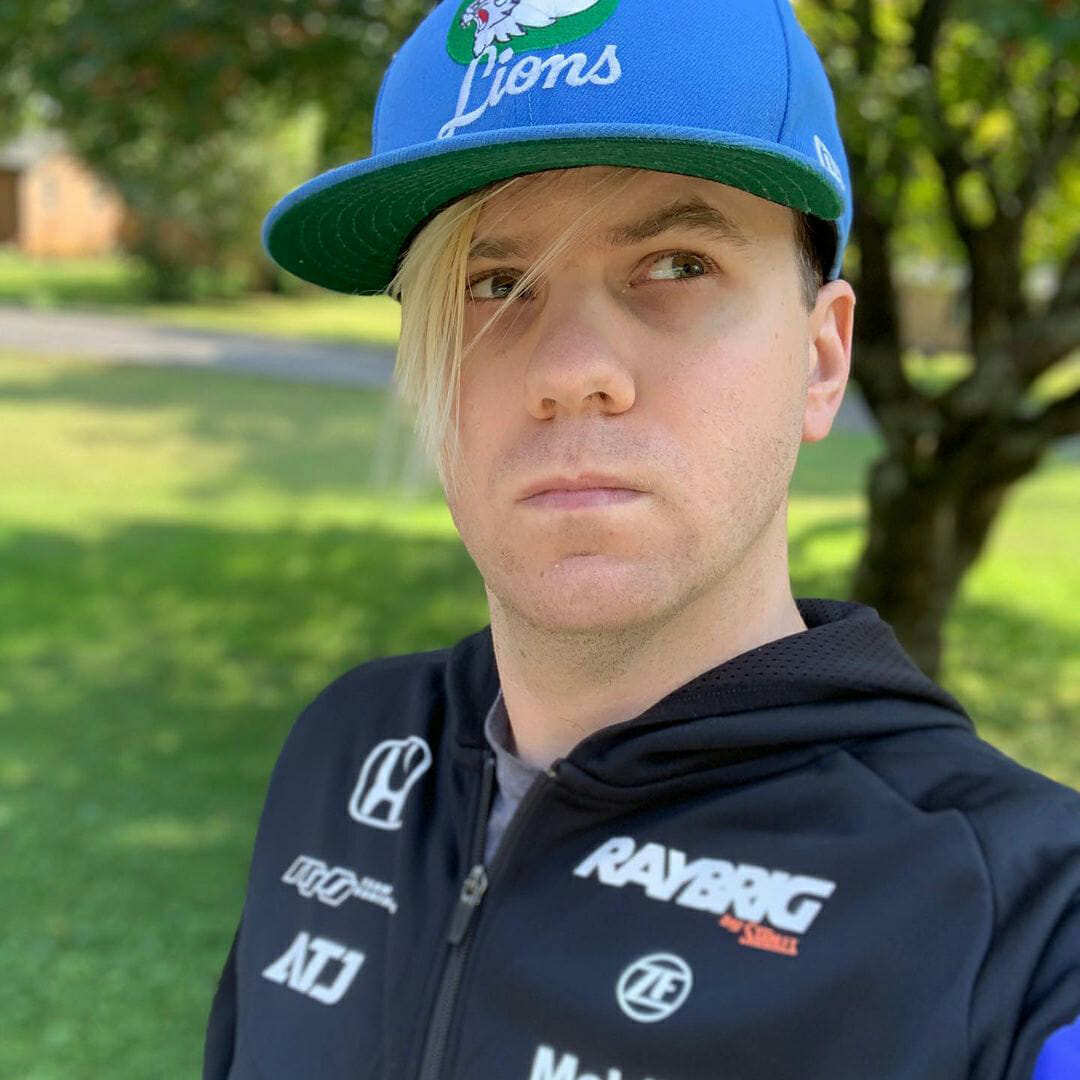Buried in a jam-packed weekend featuring the second round of the Formula One World Championship and opening rounds of MotoGP and IndyCar, Super Formula will begin its 2024 season at legendary Suzuka Circuit this Sunday (or Saturday night from the West Coast of the Americas).
For those who don’t know, Super Formula is the fastest single-seater championship outside of F1, and the highest level of single-seater racing in Japan with a history that dates back to 1973. The field in Super Formula is comprised largely of tenured professional drivers on factory contracts from Toyota and Honda, placing it closer to IndyCar than to Formula 2 – not a “feeder series”, though it has been a viable pathway to F1 before. Fun fact: It even won “Series of the Year” in our end-of-year awards podcast this winter, ahead of every other series we actually, regularly discuss on the show!
The introduction of the new Dallara SF23 chassis was a success (millions of Gran Turismo 7 and iRacing players can’t be wrong!), and so was the introduction of the series’ new premium streaming platform SFgo (which features the best “second screen experience” in motorsport streaming, bar none).
But for me, the biggest reason last year was so good was the great championship battle between Ritomo Miyata of TOM’S, and the Team Mugen teammates Tomoki Nojiri and Liam Lawson. Mugen was by far the strongest team, but Miyata’s unrelenting consistency propelled him to the championship in his fourth season, denying Nojiri a historic three-peat that only Satoru Nakajima had achieved before him, and denying Lawson the chance to become the first rookie champion since Ralf Schumacher.
Departures
It’s almost impossible to replace two talents like Miyata and Lawson, who have “graduated” from Super Formula this offseason.
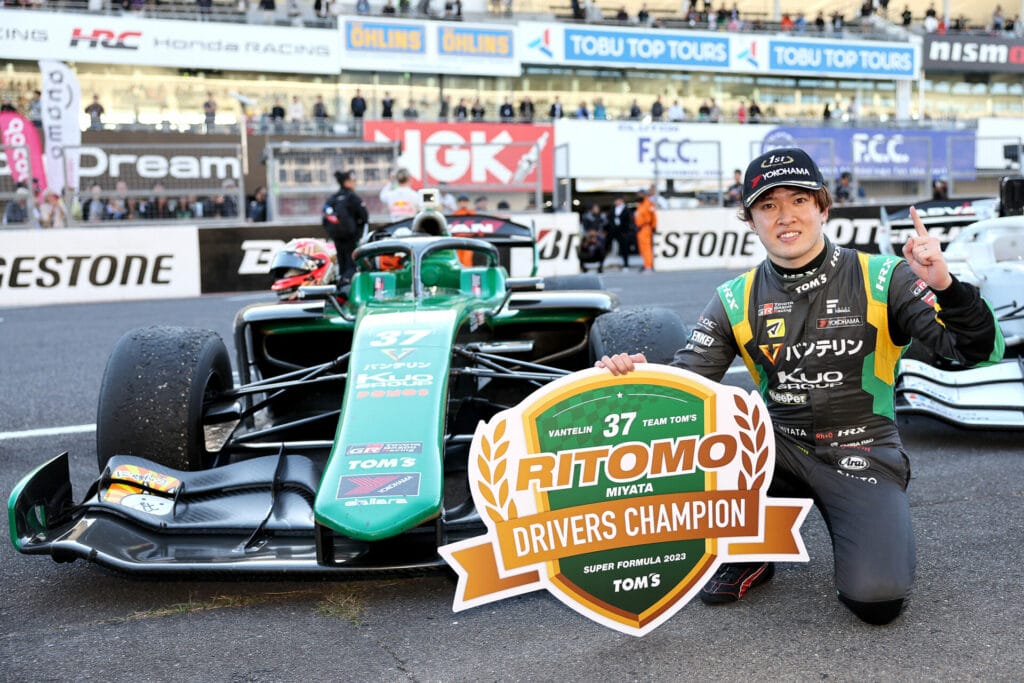
Miyata, having won every major title there is to win in Japan – capped off by being only the fifth person, and the youngest, to win both the Super Formula and SUPER GT GT500 Championships in the same calendar year – has decided to take his talents abroad. He made his Rolex 24 debut in January, he made the shock move to Formula 2 and just ran his first races (two ninth-place finishes in Bahrain were the results of great qualifying, rotten luck on standing starts, and solid recovery drives), and soon he’ll be racing LMP2s in the European Le Mans Series – and in June, the 24 Hours of Le Mans.
His long-term goal is a place in Toyota Gazoo Racing’s WEC programme and the pursuit of world championships and Le Mans victories. I openly admit I’m a fan – I admire this young man so much, as a driver and as a role model for neurodivergent people around the world – and I know he has the talent and the drive to succeed in anything he applies himself to. It’s just a shame that Super Formula and SUPER GT will be poorer without him on the grid.
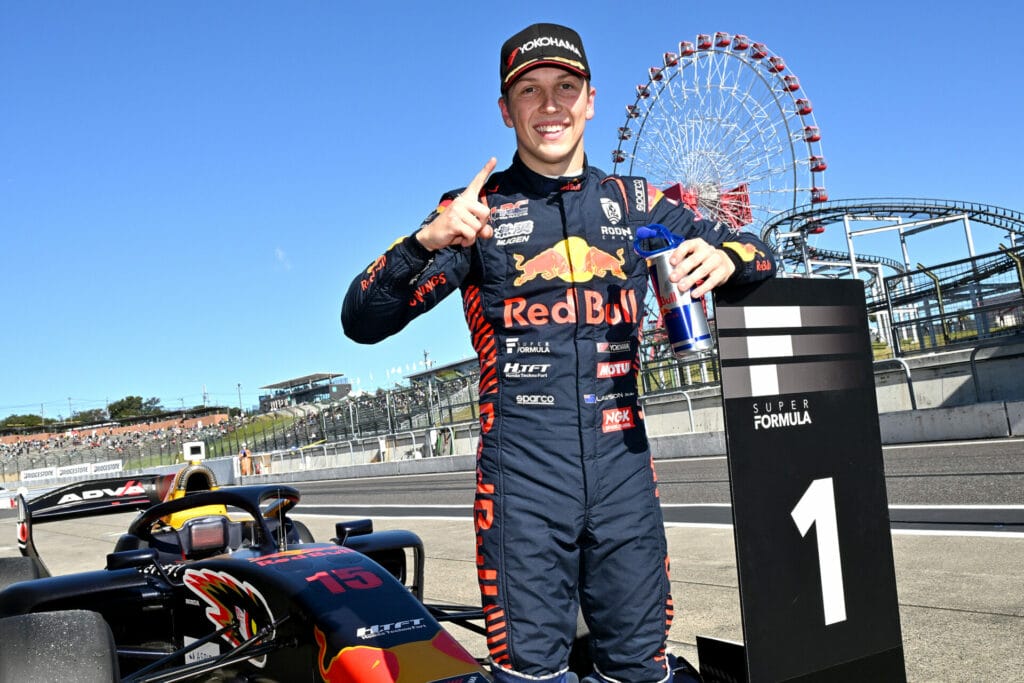
Likewise, Lawson has seemingly done all he can to prove that he’s Formula One material – including a sensational five-race relief stint in “the show” last year. But it was his three wins – including a win in his debut race, which hadn’t been done since Marc Surer in 1978 – and his championship runner-up finish in Super Formula that really cemented it for me that he belongs in F1. And he came so, so close to being the first rookie since Ralf Schumacher in 1996 to win the championship on debut.
It didn’t yield a full-time seat this year, but rather than come back and challenge for the Super Formula title again, he’s decided to stay in the F1 paddock for when that time comes.
2024 Calendar
The calendar in Super Formula features nine races at five of Japan’s major circuits – Suzuka, Fuji, Motegi, Autopolis, and Sugo.
There’ve been a couple of changes since last year to note: Fuji’s double-header weekend that previously kicked off the season has moved to October (where, no, it doesn’t rain for 31 days straight), moving the “Suzuka 2&4 Race,” a shared event headlined by Super Formula and the All-Japan Road Race JSB1000 Championship, moves back into the opening round slot. The series’ marquee event, the JAF Suzuka Grand Prix, now takes place in November to accommodate the prior change, but will still be a double-header championship finale as it was last season.
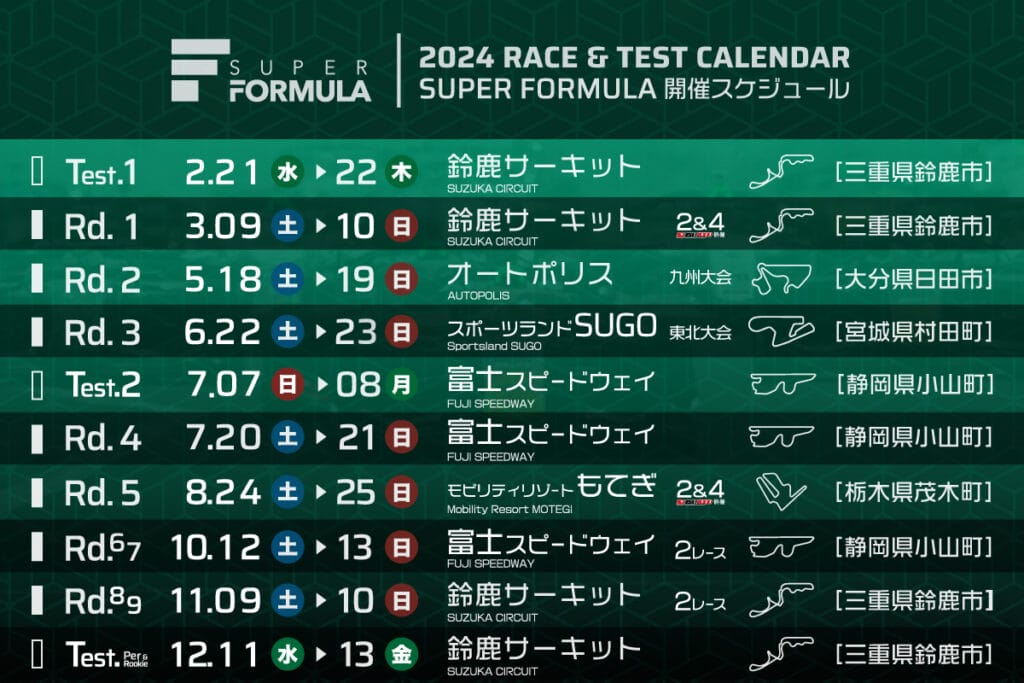
Standard race weekends feature a 90-minute practice session on Saturday morning followed by two-stage knockout qualifying. Like IndyCar, the 21-car grid is split up into two groups for Q1. The fastest six cars out of each group move on to Q2 and fight for pole position. On Sunday morning there is a 30-minute warm-up and then the race itself.
For the double-headers at Fuji and Suzuka, the 90-minute practice takes place on Friday, Qualifying is on the morning of each race (Saturday & Sunday), and there is no warm-up session.
The top ten finishers in each race score points – 20 for the winner, 15 for second, 11 for third, then 8-6-5-4-3-2-1 for the rest. Points are also paid to the top three qualifiers on a 3-2-1 scale. It’s also worth mentioning that Super Formula has a “push to pass” system like IndyCar, it’s just called the Overtake System (OTS) and you can use it for up to 200 seconds.
Changes
One change that has already been made is the introduction of spec dampers from Öhlins, a change made as a cost-saving measure at the expense of technical freedom. Some shakeups in the running order are expected, as this serves as a new puzzle for the engineers to solve.
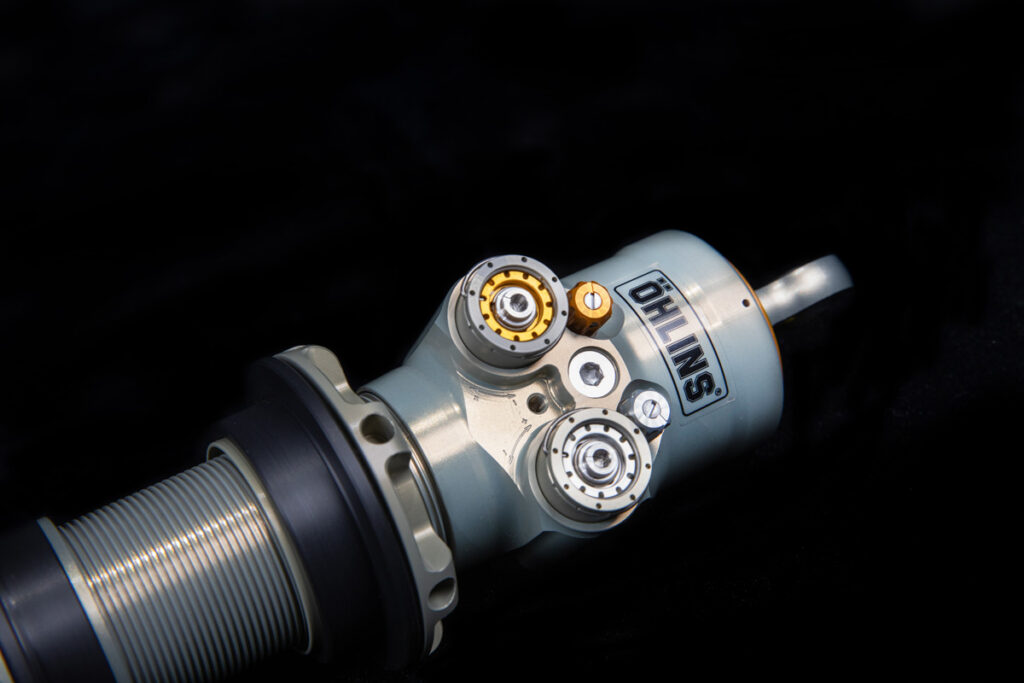
The other big change could be on the way soon – the introduction of carbon-neutral synthetic fuel, which has already become standard in SUPER GT. Super Formula has had two full-time test cars being used to develop sustainable technology, from Yokohama’s newest sustainable tyre compounds to Bcomp body panels used in the SF23.
Yoshihisa Ueno, the president of Super Formula’s promoting body Japan Race Promotion (JRP), has suggested in a recent press conference that the change may come mid-season, similar to IndyCar’s plan to finally introduce hybrid power after the Indianapolis 500.
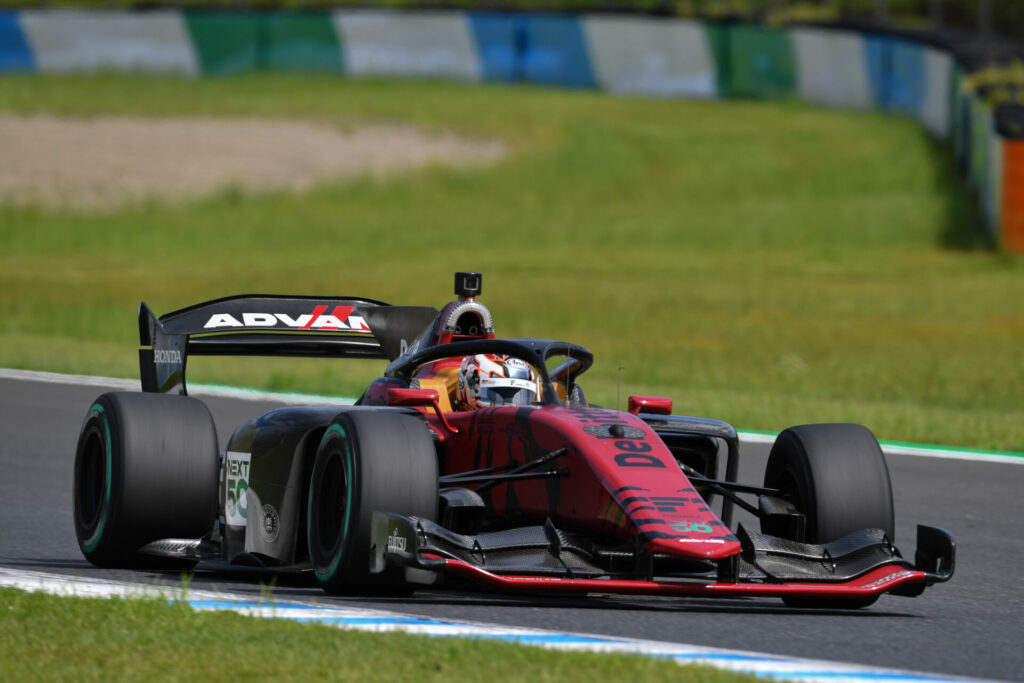
Introducing CNF harms nobody – and Toyota and Honda will have months of data on hand to ensure they don’t end up losing out when the change is made, hopefully avoiding a sudden mid-season power shift. A mid-season test at Fuji in July will likely determine whether the change will happen before 2025 or not.
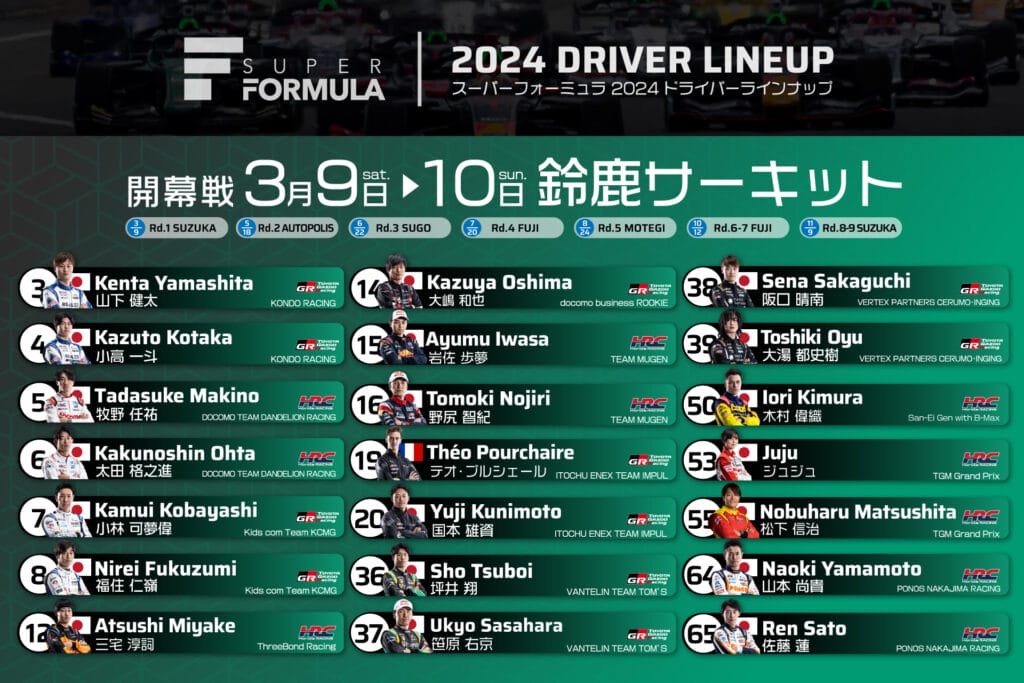
In M101 fashion, we’ll go through every team in reverse order of the Teams’ Championship from last year.
⭐ = Past champion, one for every championship / 🔰 = Rookie
San-Ei Gen with B-Max (Honda)
#50 – Iori Kimura 🔰 (2023 Super Formula Lights Champion)
What was a two-car B-Max Racing Team last year is now down to just one, with a new title sponsor and a simple blue livery – and most importantly, a new driver from the Honda Formula Dream Project, the manufacturer’s young driver scouting system.
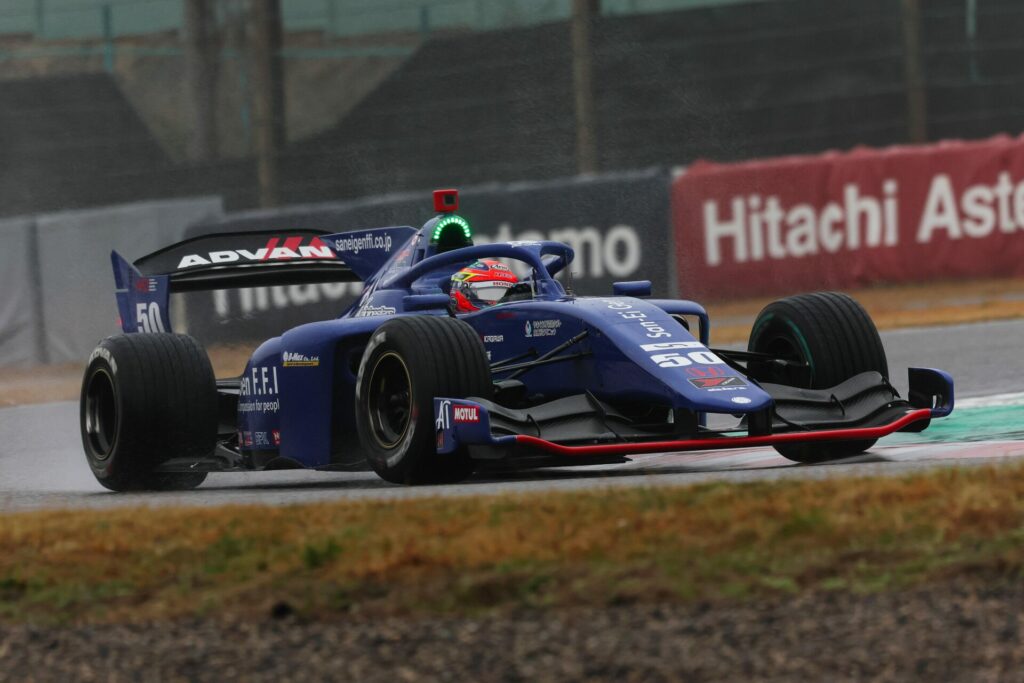
Russian-Japanese rookie Iori Kimura arrives after winning the Super Formula Lights title and getting a cup of coffee in SUPER GT, filling in for an injured Naoki Yamamoto. Yet he’s received such little fanfare on his arrival that he wasn’t even invited onto Super Formula’s all-rookie TV talk show before the start of the season.
To be fair, he will have the unenviable task of trying to elevate the form of a B-Max team that combined for just one points-paying finish between its two cars last year – so expectations are a bit grounded, even with a legend like Satoshi Motoyama serving as its team principal. Honda really likes what they saw out of Kimura last year, but he’ll be keen to perform at or above expectations to avoid being a “one-and-done” driver here.
As for the #51 car that’s been mothballed to start the year? Don’t rule it out entirely for an appearance later in the season, I’m told. The talk in the paddock is that once his commitments in America end for the year, Nolan Siegel could make a cameo appearance.
ThreeBond Racing (Honda)
#12 – Atsushi Miyake (returning after one-year absence; 14th in 2022 standings, 1 podium, 4 top-10s)
Someone new to Super Formula will look at ThreeBond Racing’s livery and see a cheap imitation of McLaren’s identity – but the Japanese adhesive company can claim papaya orange as part of its long racing heritage too, you know!
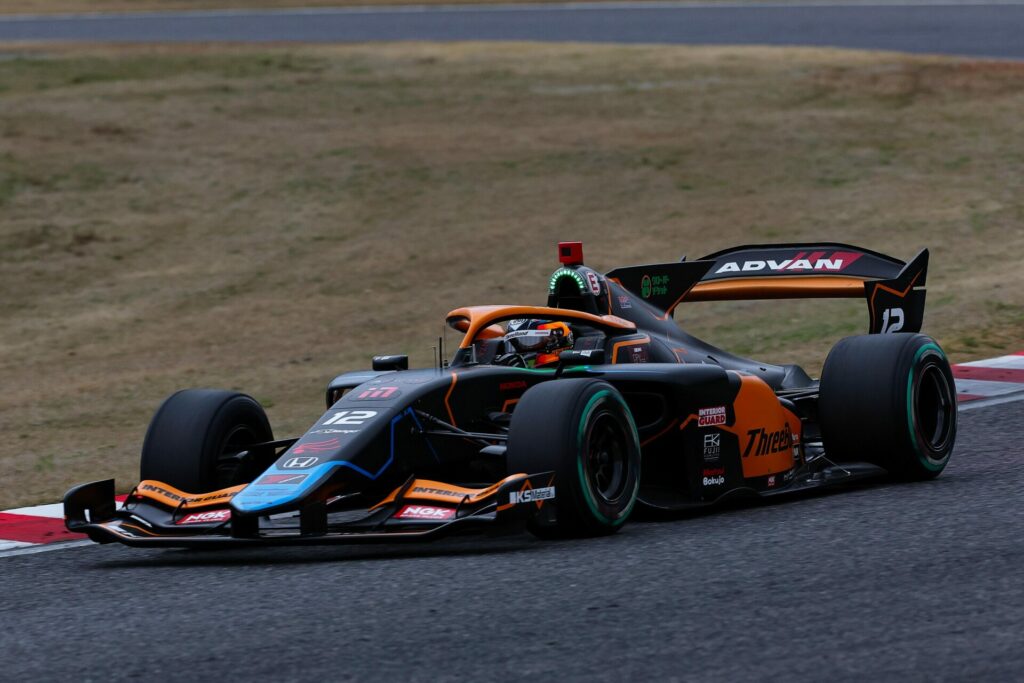
The big worry for me at ThreeBond isn’t the talent of new signing Atsushi Miyake, the only Nissan works driver competing in the series (amazingly, this used to be more common). Miyake is a very underrated talent who’s now finally getting his opportunities at the highest level. Two years ago when he was at TGM he entered the year as an out-of-left-field pick to drive took a podium and almost won Rookie of the Year honours! But…his placement isn’t really ideal for his return to Super Formula.
As either ThreeBond Racing or Drago Corse, this team has never gotten a podium finish in parts of seven prior seasons – and hasn’t finished a race better than 7th since coming back from a hiatus in 2020. Frankly, Nirei Fukuzumi’s last two seasons here ended up being a waste of his skill and it was part of what drove him to leave Honda for Toyota. That was a wake-up call that team principal Ryo Michigami needed to make changes – including hiring a new technical team to handle vehicle maintenance and preparation.
Miyake and ThreeBond didn’t really light the world on fire in pre-season testing either, compromised by mechanical problems on the second day. That doesn’t inspire confidence – I suspect the first part of 2024 could be very, very difficult for the other papaya and black team.
docomo ROOKIE Racing (Toyota)
#14 – Kazuya Ōshima (14th in standings; 1 top-5, 3 top-10s)
Now, if you looked at ROOKIE Racing’s new black and red livery and then looked at Toyota Gazoo Racing’s new matte-black livery for its world championship factory teams in WEC and WRC, you might think this is all a fine coincidence.
But ROOKIE Racing is Akio Toyoda’s second pet racing project (Gazoo Racing, as it was known in 2007, was his first). This team has positioned itself to be Toyota’s new flagship team in Japan, with top-of-the-line personnel, state-of-the-art facilities including a new factory at Fuji Speedway, and programmes in GT500, Super Formula, and Super Taikyu.
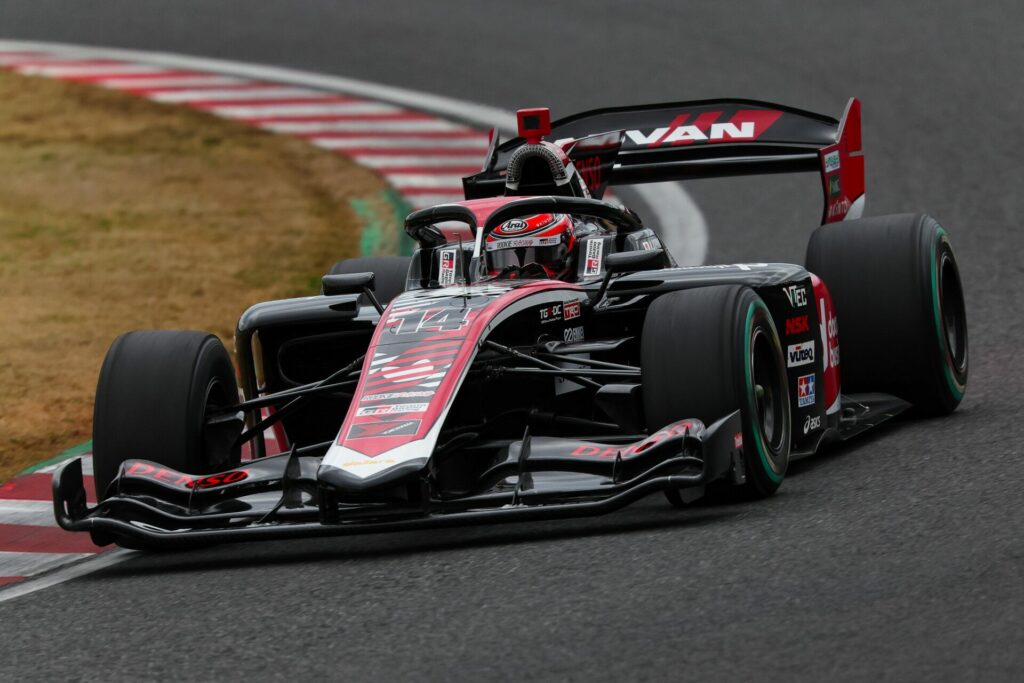
That’s why the results through four seasons seem massively underwhelming for a team of this reputation. The good news is that veteran driver Kazuya Oshima scored the team’s best finish last year and nearly doubled its points tally from the three previous seasons. The bad news is that it was still only 13 points, though it’s infinitely better than going scoreless in 2022.
Oshima, who turns 37 in April, has never had the sustained success in Super Formula that he’s enjoyed in the junior formula series and in SUPER GT. He’s won titles in both GT500 and GT300 – but hasn’t won a Super Formula race in nearly 14 years. It’d be easy to pin all the problems at ROOKIE Racing on an ageing driver, and I’d have believed you if he had another completely terrible season in 2023. But I’d like to think that his fourth-place run at Sugo could spark a late-career renaissance for a man who is very respected within the Toyota racing family.
His good friend Hiroaki Ishiura, who was a late-bloomer himself and a two-time champion of the series, will be back as the team principal – and to help reinforce the technical team, none other than Ryan Dingle – race engineer for the #8 Toyota GR010 Hybrid Hypercar – has been hired as an advisor to the team. It should work out because frankly, nothing less than success should be good enough for a team with this sort of structure and investment behind it.
TGM Grand Prix (Honda)
#53 – Juju (Noda) 🔰 (2023 F2000 Italian Formula Trophy Champion, 8th in Euroformula Open)
#55 – Nobuharu Matsushita (19th in 2023 standings; 1 top-10)
What to think of TGM Grand Prix, the lone wolves of the Honda camp? A glance through the team’s lineage as Team Goh will reveal a GT500 crown with McLaren, a Le Mans 24 Hours win with a privateer Audi and an alliance that brought IndyCar champion Alex Palou to America – among other accomplishments. In its current state, it is the racing label of Servus Japan, a respected technical firm with some of the best engineers in Japan under its wings.
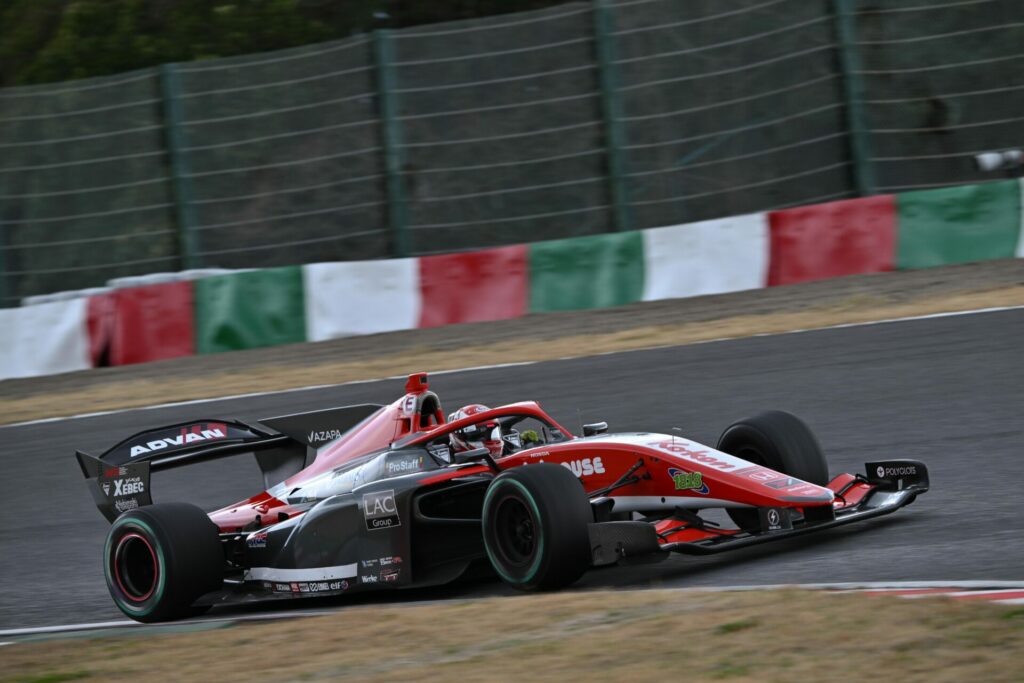
But Kazuhiro Ikeda’s renegade style as the team boss has moulded TGM into an enigmatic and unpredictable presence. Look at the way the driver search went for the #55 car. It looked like it would go to a pay driver given what seems like a frosty relationship between Honda and TGM to some observers. Rasmus Lindh and Raoul Hyman yielded to Nobuharu Matsushita, who’s exactly the driver TGM needs…but nobody thought they’d ever get.
That only leads to more questions. Is Matsushita paying for this seat out of his own pocket like Toshiki Oyu did last year? If so, does he have enough for the full season? Or, has TGM relented and let a works driver into its ranks regardless of budget? Matsushita’s results last year were poor, but his win at Suzuka two years ago in the wet isn’t too distant and a reminder of just how spectacular a driver he can be.
However, we all know who’s the big draw. Juju Noda (racing under the mononym Juju, in true Ichiro style) is about to become the youngest Super Formula driver ever, the fourth woman in series history and the first from Japan, bringing with her a wave of mainstream media coverage and fan interest to Super Formula that the series hasn’t enjoyed in what feels like an eternity. Chances are, they know the story of the child prodigy who was driving F4 and F3 cars at an age when other kids were still in karts. Or they saw the reports about a Japanese girl winning international formula car races making national news.
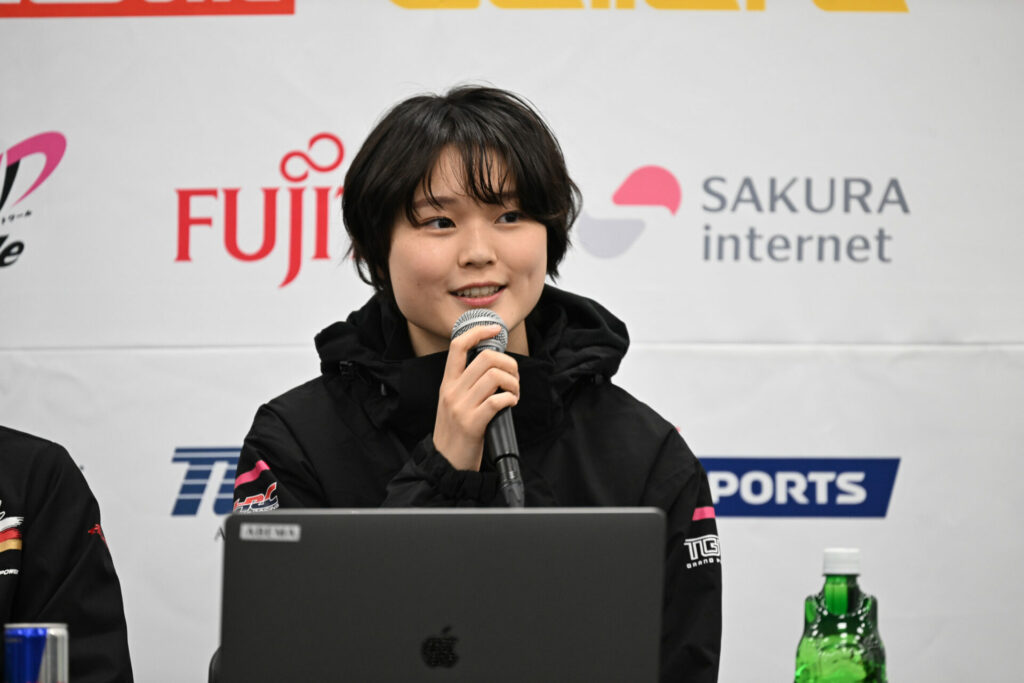
Juju turned 18 last month and has reached a destination that I and many others thought she’d reach by this time – back when we all heard the stories and thought, ‘She might be the one.’ Her way-the-hell-off-the-beaten-path career overseas, steered by her and her father Hideki Noda, hasn’t gone the way any of us hoped for. In testing, she’s been fast enough to make the 107% minimum time – but had a few incidents too, driving the fastest car she’s ever raced against the toughest competition she’s raced against by several orders of magnitude. I fear her absolute ceiling may only be ‘celebrity backmarker’, which would be heartbreaking.
But you would have to be an absolute fool to think, even with odd remarks from Papa Noda that were interpreted as lobbying for a weight break, or headlines from non-racing outlets that show a lack of intermediate-level knowledge, that Juju’s presence and the windfall of attention that she has brought to Super Formula is a net positive – especially if you’re someone who wants to see the series emerge from the shadow of SUPER GT and F1 in the home market.
For her sake, I just hope she continues to improve and enjoy her racing.
Kids com Team KCMG (Toyota)
#7 – Kamui Kobayashi (11th in 2023 standings; 5 top-10s)
#8 – Nirei Fukuzumi (16th in 2023 standings; 3 top-10s)
KCMG, the only team of non-Japanese origin in Super Formula, is a very interesting one. This is KCMG’s 15th year in the series, and they’ve never won a race. Last year in testing they set headline-grabbing times but failed to deliver when the real racing began and slumped back in the midfield mire.
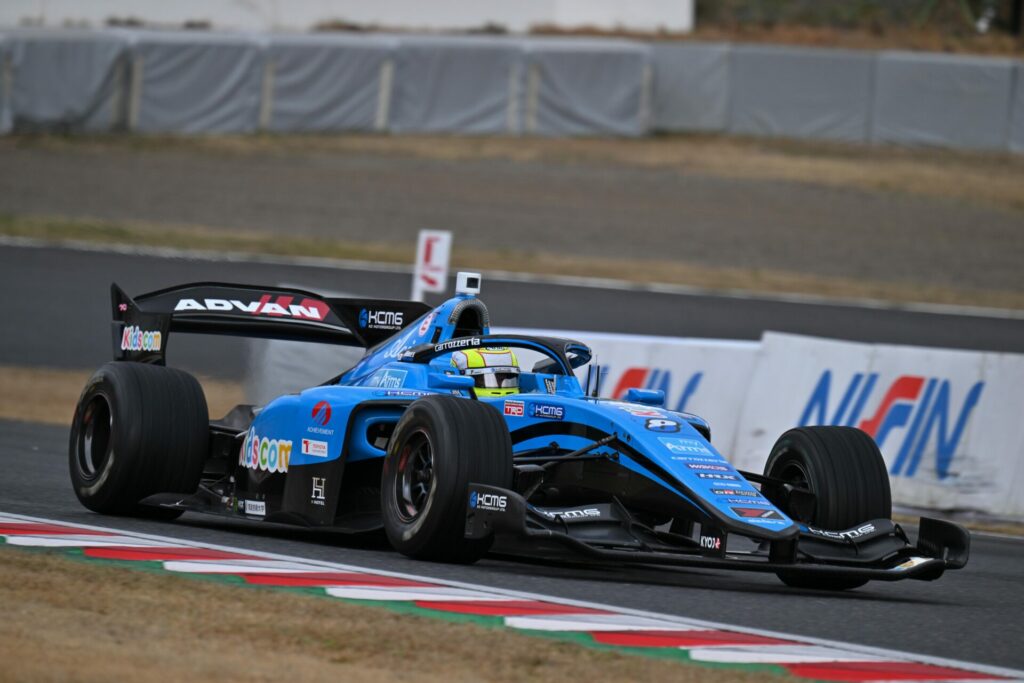
We all know Coach Kamui here, the dynamic, fearless, groundbreaking driver who’s won almost everything his sport has had to offer as a driver. But in 64 races across nine seasons, somehow he’s never won in Super Formula – though he’s come agonisingly close during his tenure at KCMG. He was ready to leave the series to focus more on his ever-growing commitments as Toyota’s team principal in WEC. Then he had an epiphany: The more races he does, the fewer board meetings he has to sit through! And that’s how Kamui reconsidered and came back for another go as the series’ oldest driver.
Nirei Fukuzumi is the newcomer in the #8 car, and if you only know him from his brief time in Europe, you’d be best served to wipe that awful F2 campaign at Arden from memory (his GP3 tenure at ART was much better). Fukuzumi has been a title contender in Super Formula and GT500, regarded as one of the fastest drivers in the series, and now he’s one of two drivers this off-season who has defected from Honda to Toyota. Fukuzumi’s motivation for changing camps was the desire to eventually get another crack at international motorsport that better reflects his true ability.
And guess what? Both light blue KCMG cars were quick in testing – again – led by Fukuzumi in second place. If there was ever an opportunity for this team to finally get that first win, this is it. If for no other reason than for Kamui Kobayashi to finally get that first win that’s eluded him for so, so long…
PONOS Nakajima Racing (Honda)
#64 – Naoki Yamamoto ⭐⭐⭐ (13th in 2023 standings; 4 top-10s in 7 races)
#65 – Ren Sato (10th in 2023 standings; 1 top-5, 5 top-10s)
The most important development at Nakajima Racing is that three-time Super Formula Champion Naoki Yamamoto is back after a neck injury sustained in the SUPER GT race at Sportsland Sugo. It was a terrifying crash that forced him to either undergo surgery or retire from racing.
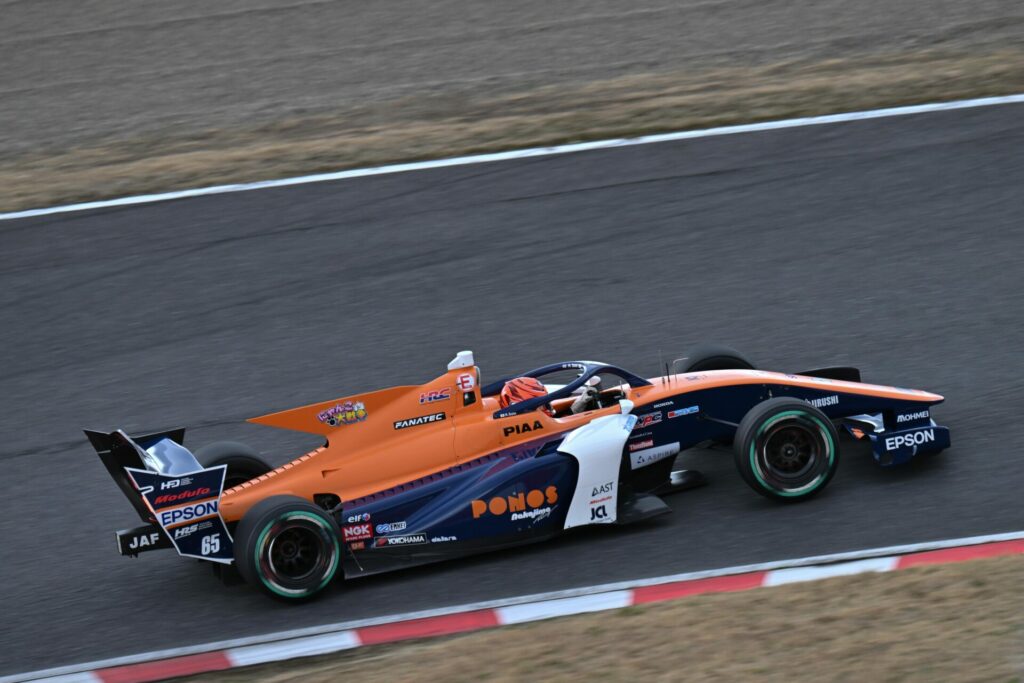
Thankfully, his body is fully healed now, and Yamamoto has rightfully been retained to show that he’s still one of Japan’s elite drivers He has just one podium – a dominant pole-to-win in the wet at Motegi – since he rejoined his first Super Formula team in 2020, but that shows that the 35-year-old legend is still more than capable of the brilliance that has led him to win both the GT500 and Super Formula titles in the same calendar year – twice – and made a firm advocate out of none other than Formula One World Champion Jenson Button.
Nakajima Racing now has a new livery courtesy of mobile game dev PONOS, the team’s new title sponsor. The team is still the namesake of founder Satoru Nakajima, the nation’s first true F1 hero and a five-time Super Formula champion – but he’s since passed on day-to-day running to Honda works driver Takuya Izawa, who has a strong rapport with Yamamoto.
Keep a keen eye on third-year driver, Ren Sato, who finished with the third-quickest time in the preseason test. I think Sato has been somewhat unfairly maligned at times – whether it was an accident that took his now team-mate out of a GT500 title fight in 2021, or getting cut from the Red Bull Junior Team after his rookie year – and has a genuine chance to break through and show the massive speed he displayed many times as a Honda junior.
Nakajima Racing hasn’t won either the Drivers’ or Teams’ titles since 2009 with Loic Duval leading the way, and the wins since have been a bit scarce – but with the talent in their cockpits, it’s still hard not to consider this team to be a contender somehow!
Kondo Racing
#3 – Kenta Yamashita (8th in 2023 standings; 1 podium, 6 top-10s)
#4 – Kazuto Kotaka (15th in 2023 standings; 3 top-10s)
Award-winning recording artist Masahiko Kondo and his team haven’t had many moments of Super Formula triumph over the years. In the 23 years that this team has been in the series, Kondo Racing has won just four races, and the 2018 Teams’ Championship. Current Formula E stars Nick Cassidy and Sacha Fenestraz came as close to winning the Drivers’ Championship as they could, but could only finish second in recent years.
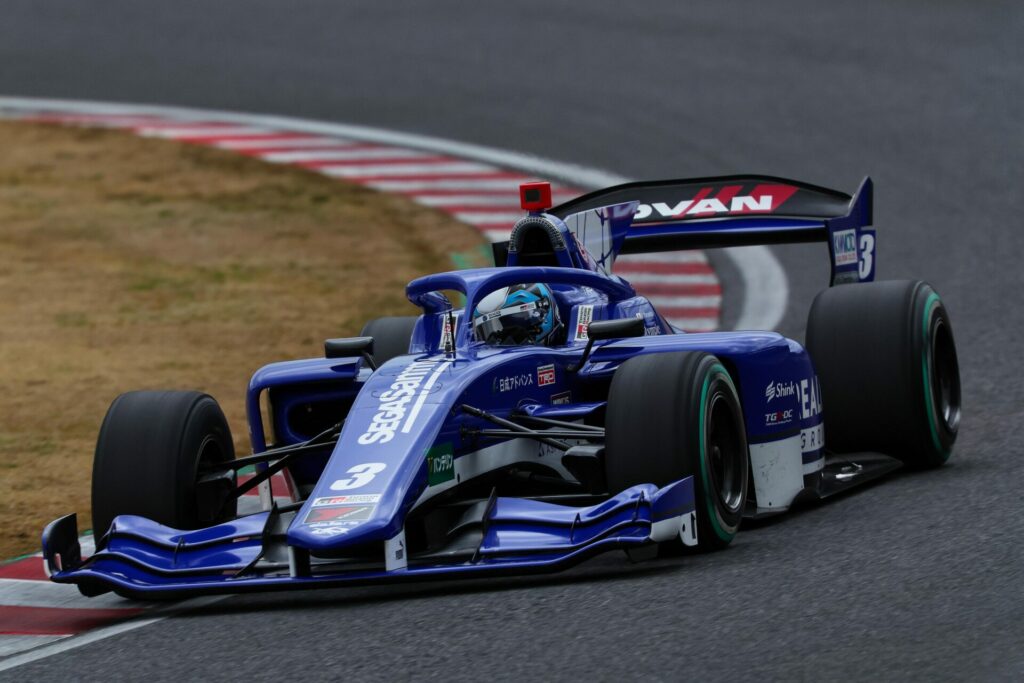
There’s been one constant over this recent period and that’s the mega-talented Kenta Yamashita, who’s spent his entire Super Formula career at Kondo Racing – now entering year eight. “Yamaken” shed tears when he finished third at Fuji last year for his first podium in three years. It astonishes me that his last win was in 2019, 34 races ago – in the same year he won his first GT500 title.
So when Yamashita rocked up at the pre-season test feeling as confident as he’d been in this environment in some time, then set an OTS-assisted flyer to finish with the fastest time in pre-season testing – that was a statement of intent that one of Japan’s most naturally-gifted drivers could be poised to get back to the top step of the podium after some lean years that betray his hard-charging reputation. Remember: Before Ritomo Miyata, Kenta Yamashita was the young driver Toyota saw as the future of its top-tier prototype programme – and he gave it up by choice during the pandemic to be closer to home.
As exciting as the prospect of a Yamaken title charge may be, 2024 is also a big year for Kazuto Kotaka, the most recent Super Formula graduate from the Toyota Gazoo Racing Driver Challenge (TGR-DC) academy. Better than he was as an accidental full-timer in 2021, but he still left a lot of room for improvement after 2023.
I also worry about Toyota’s decision to skip over him to fill vacancies in the GT500 ranks this year, and with other TGR-DC prospects chomping at the bit for a promotion, Kotaka likely can’t afford to be lost in the mid-pack again this year if he wants to stay in the series. It’s a big honour for a Toyota or Honda driver to fight with the “two swords” in GT500 and Super Formula. But this is the sword that’s given out to fewer drivers – and if taken away, this is also the one that’s harder to get back.
Itochu Enex Team Impul (Toyota)
#19 – Theo Pourchaire 🔰 (2023 FIA Formula 2 Champion)
#20 – Yuji Kunimoto ⭐ (17th in 2023 standings; 4 top-10s)
It’s all change on the driver front at Team Impul, now under the day-to-day management of second-generation team principal Kazuki Hoshino, son of the great Kazuyoshi Hoshino, the six-time series champion and all-time wins leader.
Sadly, this has meant saying goodbye to one of my favourite drivers in the series, Ryo Hirakawa, who has traded in his Super Formula seat for a McLaren F1 test role, to supplement his World Endurance Championship campaign at Toyota. Another personal favourite – Super Formula’s “Mr. Excitement,” Yuhi Sekiguchi, has also left Super Formula after failing to score a point last year, a crushing fall from grace for a seven-time race winner who’s had some truly stirring performances over the years.
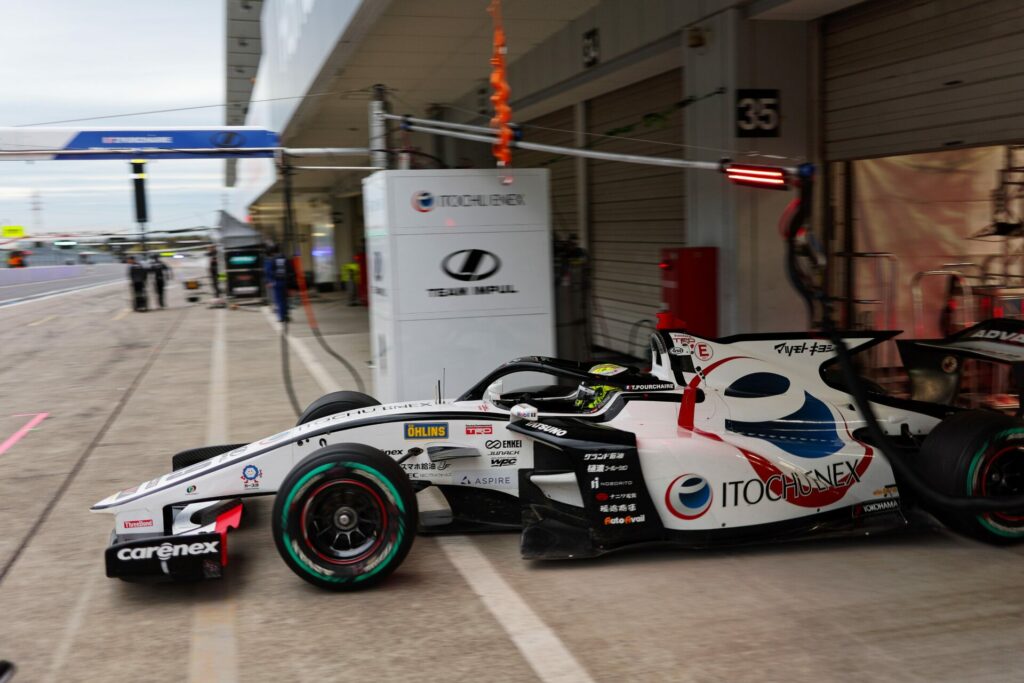
In their places come 2016 Super Formula Champion Yuji Kunimoto, and the reigning Formula 2 Champion Theo Pourchaire, the only non-Japanese driver in the field and the subject of most foreign interest in Super Formula for 2024.
The obvious angle for Pourchaire is his continued pursuit of a Formula One drive. He’s taking the path that Pierre Gasly, Stoffel Vandoorne, and Liam Lawson have recently taken, using Super Formula as his final step to a seat. But I say this of any newcomer from abroad with F1 aspirations – and it should now be clear through the previous examples mentioned: This is a harder challenge than F2. Pourchaire is racing against older, more experienced professional drivers on unfamiliar tracks, in a car that is faster than what he’d driven before. Please, miss me with any cracks about “reject series”, “farmer’s league” or the like.
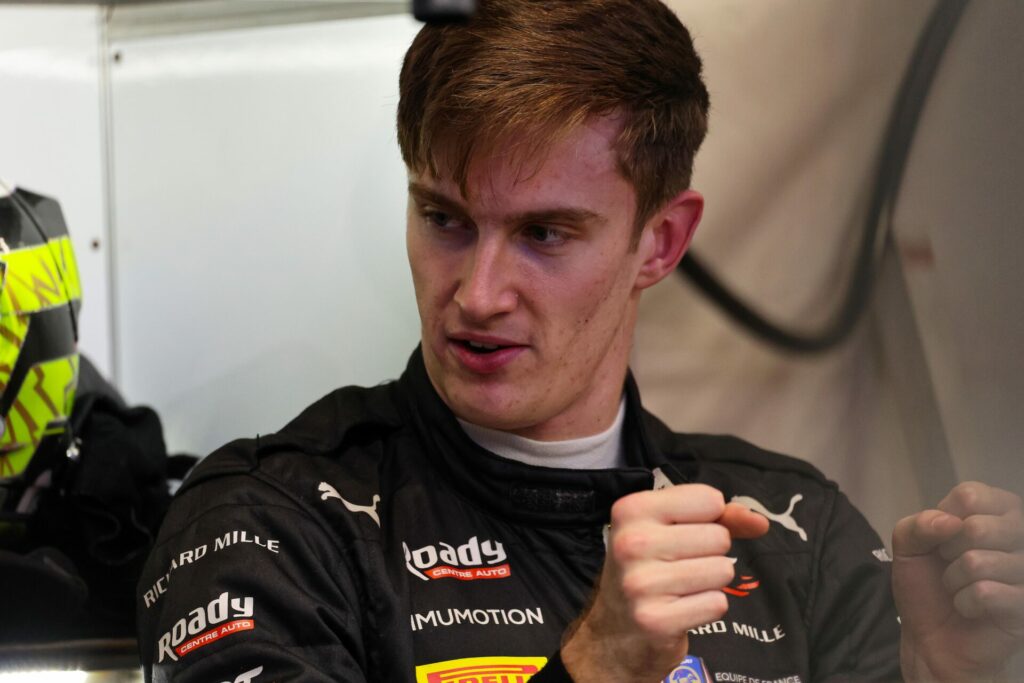
That’s not to say Pourchaire won’t perform well here. In fact, after shaking off a spin on his first out-lap on wet tyres, the Frenchman made no further mistakes and had a good test all around. He’s effectively replacing Hirakawa and inheriting his crew. Hirakawa, over the last four years, finished top-five in the standings every year, with three wins and 11 podiums over that span.
A top-five finish in the table with wins and podiums is a reasonable and acceptable benchmark for Pourchaire to reach with Impul and should absolutely be good enough for him to finally break through and land a Sauber F1 race seat in 2025.
Spare a thought also for Kunimoto, whose title-winning 2016 season now feels like a distant memory – he hasn’t won a race since. It feels like Toyota has shuffled the teams a bit to give the 14th-year veteran one more chance to recapture that old glory. If he at least scores a point, he’ll do better than Sekiguchi did last year. But he may need more to avoid a muted end to his single-seater career.
Vertex Partners Cerumo-INGING (Toyota)
#38 – Sena Sakaguchi (12th in 2023 standings; 1 top-5, 5 top-10s
#39 – Toshiki Ōyu (9th in 2023 standings; 2 pole positions, 1 podium, 2 top-10s)
The continued collaboration between INGING Motorsport and Team Cerumo hit its peak when Hiroaki Ishiura and Yuji Kunimoto combined for three straight Drivers’ titles from 2015 to 2017. Cerumo-INGING hasn’t hit those heights since, but is still a solid team – with a very fascinating line-up in 2024.
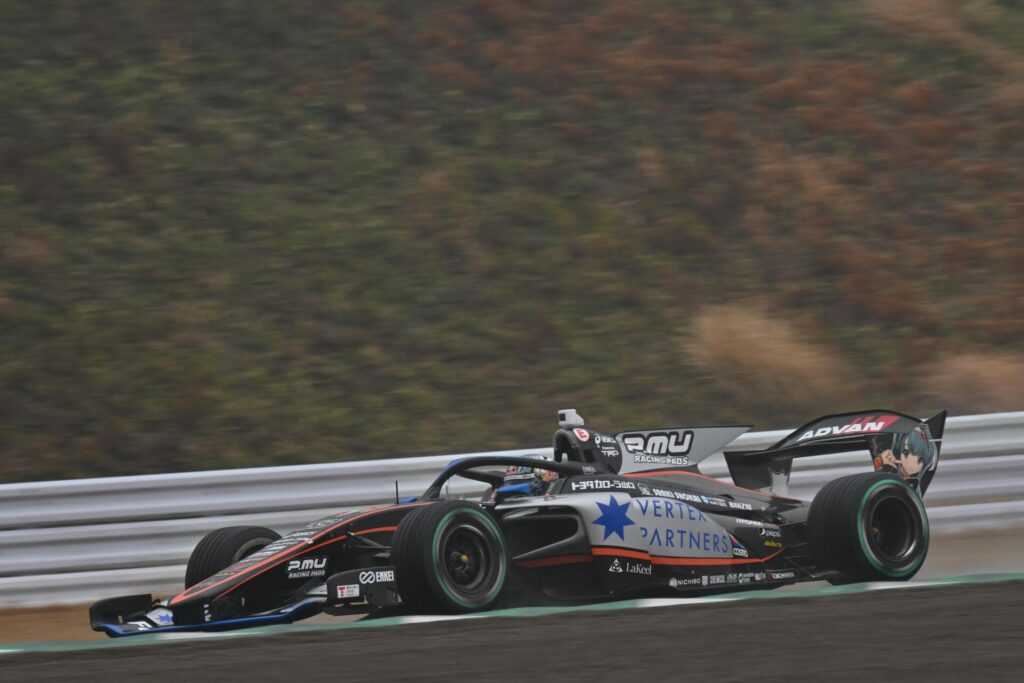
The addition of Toshiki Oyu, the other big defector from Honda to Toyota, could be a game-changer. Oyu’s departure was, shall we say, less amicable than Fukuzumi’s. The story of him spurning Honda’s offer to drive for Dandelion Racing last year to race for TGM Grand Prix is well-documented, and so is the fact that Honda wouldn’t fund his desired destination and left him to pay out of his own pocket until, we believe, the money ran out before the end of the year. He also broke his collarbone in July and raced through his injury weeks later in SUPER GT – reportedly at the behest of Honda and his former team ARTA.
Oyu has a superstar personality and more importantly, the speed and tenacity to be a multi-time series champion. When he’s on his game, he is unbeatable – and he had amazing performances last year. But across four seasons he’s still yet to find consistency to match that speed, and the most critical comments of him all have a common theme: Too wild on the track with a poor attitude. But Yuji Tachikawa, the team principal, doesn’t seem bothered by that perception – in fact, he seems to have taken a liking to Oyu and the hope is that he’ll find that next level that’s been missing in his still-young career.
With Sho Tsuboi’s departure from the team, Sena Sakaguchi (yes, named after the three-time World Champion) is now the tenured man and a Tachikawa protege capable of some stirring drives and big results. He has as much speed and raw talent as his new team-mate – but he just hasn’t been able to match the high points of his 2021 rookie season when he bagged a couple of podiums and outperformed Tsuboi across the year.
I think there’s real potential for Cerumo-INGING to make a move back up the order with the two young talents they have. They just need to avoid a slump like the one that ultimately prevented Tsuboi from making a serious title push in the second half of 2023.
docomo Team Dandelion Racing (Honda)
#5 – Tadasuke Makino (6th in 2023 standings; 1 pole position, 2 podiums, 6 top-10s)
#6 – Kakunoshin Ōta (7th in 2023 standings; 1 win, 2 podiums, 3 top-10s
Some might remember Dandelion Racing as the team Stoffel Vandoorne raced with on his way to a brief F1 career that should have gone so much better than it did. This was also the team with which Naoki Yamamoto won his third title in 2020. I’d consider this team to be a championship dark horse, but their cars are all-white and frankly, it might be a disservice to say they’re anything less than a strong contender.
Dandelion Racing had a reputation of having great damper packages in the time when it was open-spec. The move to spec dampers did little to curb their performance in pre-season testing, where sixth-year driver Tadasuke Makino set the fastest time in three out of four sessions and was “only” fourth in the last one because he didn’t use the OTS on his flying lap.
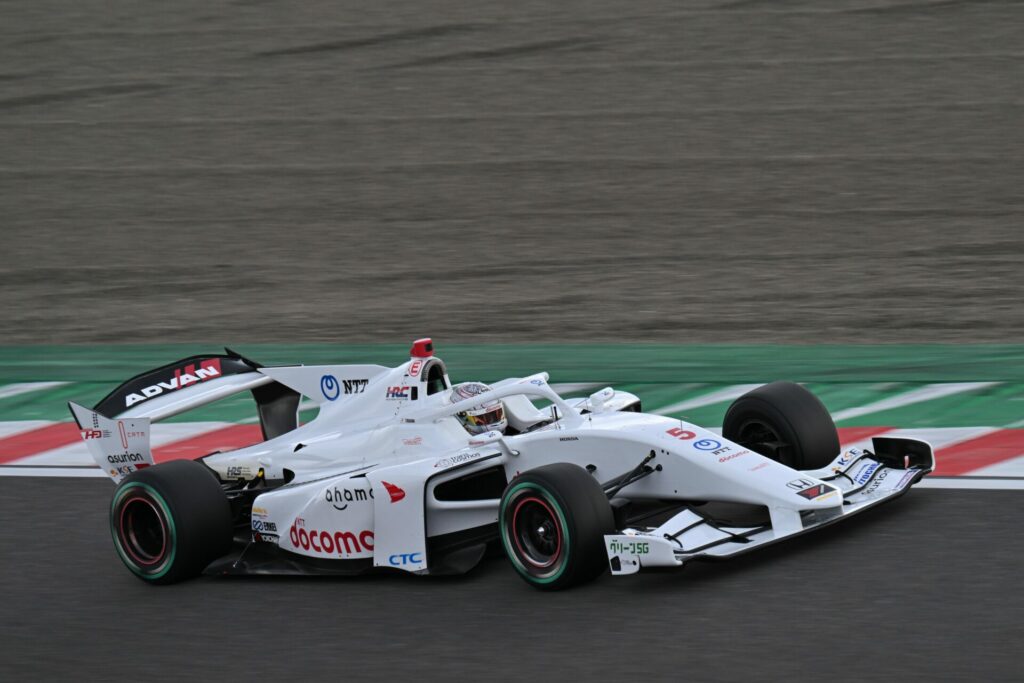
I have been a massive believer in the talents of Makino since he was a teenager just breaking his way into the HFDP system, through that F2 feature win in Monza 2018, his first GT500 title at Team Kunimitsu. In his first Super Formula race in 2019, only a loose wheel kept him from winning on debut at Suzuka. He’s now done 37 races and has yet to win in this series – but I firmly believe that not only will he get his first win, he’ll be a legitimate title contender.
Yes, rookie team-mate Kakunoshin Ohta got the win to close out 2023 – but he’ll admit, as will Dandelion Racing, that Makino taking the reins and leading the way in planning setups was a big reason why this team was good enough to be able to fight for wins last year. He’s now starting to become a true team leader, and I think the success that comes with it will be paid forward with interest.
Of course, Ohta’s no slouch either. He turned a dreadful first half spent shaking off the jitters from a SUPER GT testing crash with no finishes better than 15th, into a hot streak to end 2023 that culminated in his first win at Suzuka where he ended up being the spoiler in the title fight. Ohta went from being buried in the HFDP depth chart in F4 not long ago, to being touted as a future champion of Japan’s two big racing series. And I think his recent success is also sustainable.
The vibes seem really good at Dandelion, a team from the Kansai region with two Kansai drivers leading the way with bright futures ahead of them. I know it’s tough for any team to have sustained success in Super Formula – but if anyone can break up the expected Mugen/TOM’S duopoly this year, it’s this group.
Vantelin Team TOM’S (Toyota)
#36 – Sho Tsuboi (4th in 2023 standings; 3 podiums, 6 top-10s)
#37 – Ukyo Sasahara (22nd in 2023 standings; best finish of 12th in 3 starts)
2024 is the 50th anniversary of the world-famous TOM’S Racing. Team co-founder Nobuhide Tachi (the T in TOM’S) has surely set his sights on adding to his team’s incredible total of championships, but he’ll have to do so without the talents of the “Double Champion” Ritomo Miyata. But if you can’t have Miyata leading the way, you can always have his two-time and defending GT500 champion co-driver!
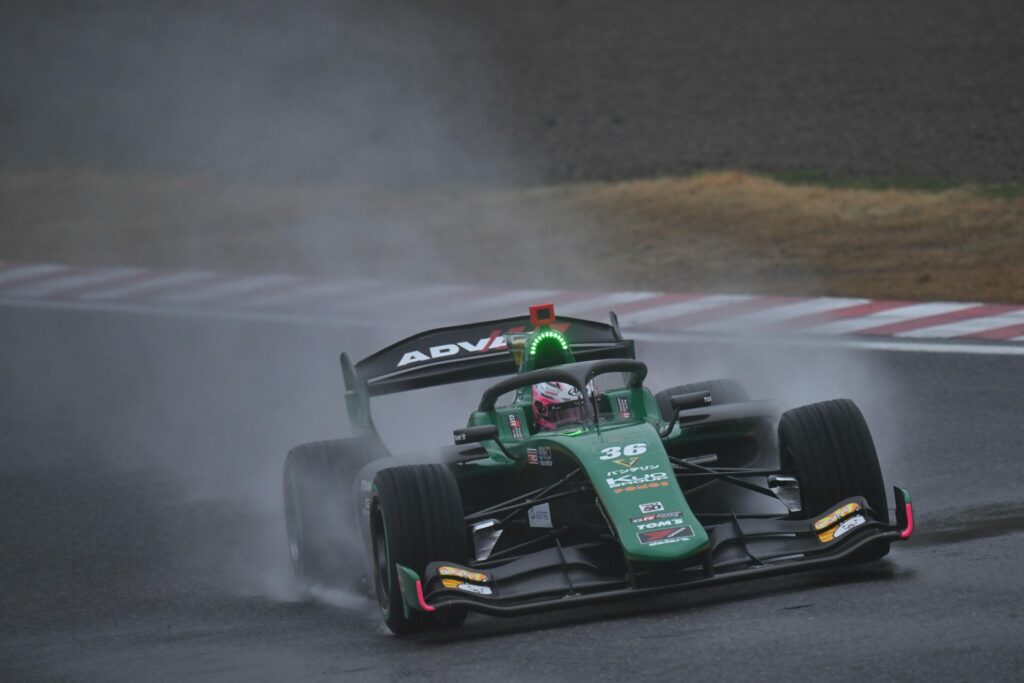
He may not throw 165 km/h fastballs or crush towering homers, but the racing version of “Sho-time” is an immensely talented driver in his own right and was the best choice to take over what was effectively Miyata’s old ride with his old crew. Sho Tsuboi was the best driver in Super Formula outside the big three of Miyata, Lawson, and Nojiri – and while he hasn’t won a race here since December 2020, he is still very, very highly regarded in terms of his all-around skill and leadership.
And when you combine that with the strength of his TOM’S team in SUPER GT, there’s every chance that Sho Tsuboi could make a run at a “Double Championship” of his own in 2024!
As for Ukyo Sasahara, this is the most security he’s ever had as a Super Formula driver in his career, which has to be uplifting. It all started when he was a COVID-enforced substitute for the man Red Bull wanted at Mugen in 2020, Juri Vips. He struggled and from there, Honda was always reluctant to give him another chance even after podiums and even victories in the two years that followed. That sparked his move to Toyota last year…and he still had to spend the first part of 2023 driving the R&D car until Giuliano Alesi (son of actress Kumiko Goto) was removed from the cockpit after a year and a half of underwhelming drives.
When Sasahara is at his best, he’s outstanding. Wipe away that partial ’23 season – he now has a fresh chassis to replace the one that was totalled in one of the worst 130R crashes I’d seen in…four months, and a full off-season to prepare like a racing driver. He’s exactly what TOM’S has needed since it was Nick Cassidy and Kazuki Nakajima leading the way: More than just a rear gunner, but someone, maybe, who can take the championship fight for himself.
This is still the best Toyota team in the game.
Team Mugen (Honda)
#15 – Ayumu Iwasa 🔰 (4th in 2023 FIA Formula 2)
#16 – Tomoki Nojiri ⭐⭐ (3rd in 2023 standings; 3 wins, 4 pole positions, 5 podiums)
The bad news for those looking into Super Formula as a change of pace from the monotony of Formula One is that the series’ best team is still sponsored by Red Bull and has Honda engines. The good news is at least Mugen is sometimes vulnerable to attack.
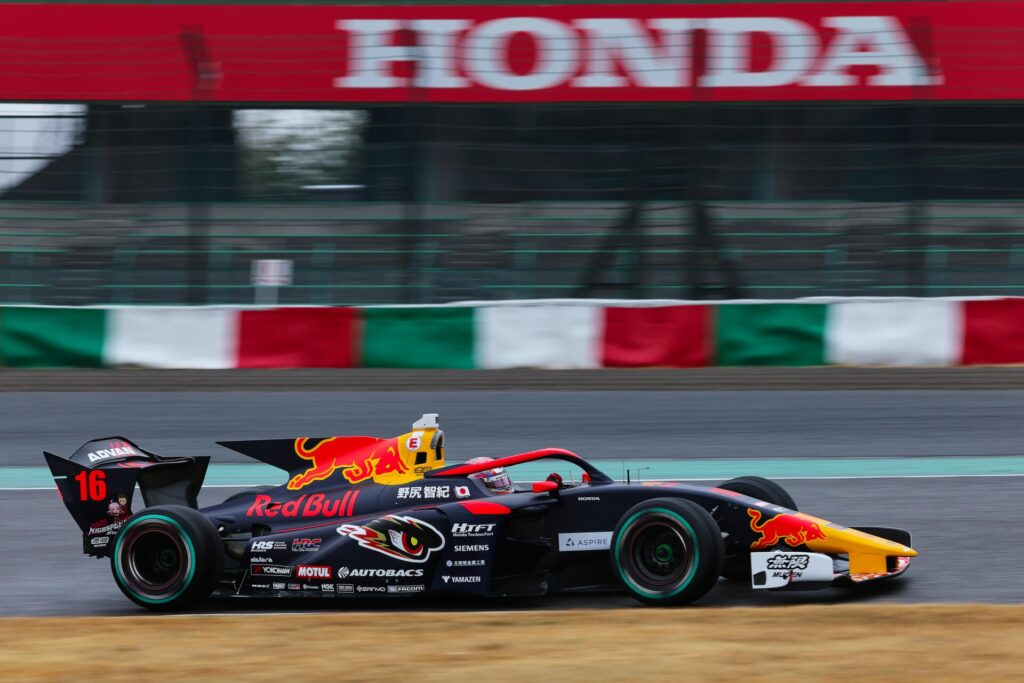
But Mugen has been the class of Super Formula for some time, it’s safe to say. Six wins, split evenly between Tomoki Nojiri and Liam Lawson. Back-to-back Teams’ titles, and three out of the last six Drivers’ championships. It’s a wonder how neither of its drivers won the title last year – and in the case of the two-time champion Nojiri, it was just a matter of terrible luck. He lost up to 43 points last year after tangling with his SUPER GT co-driver in a battle for the lead at Suzuka, then was ruled out of the next round at Autopolis due to a collapsed lung. Nojiri only finished half a point behind Lawson and 8.5 points behind Miyata.
Since the start of 2021, Nojiri has won eight races, 12 poles, 17 podiums – and boasts a whopping 3.5 average finish. (His average finish last year, minus the retirement and the missed race, was 2.71!) And you know he’ll be aiming for that third Super Formula championship that eluded him. Until proven otherwise, Tomoki Nojiri should always be considered the favourite for the championship.
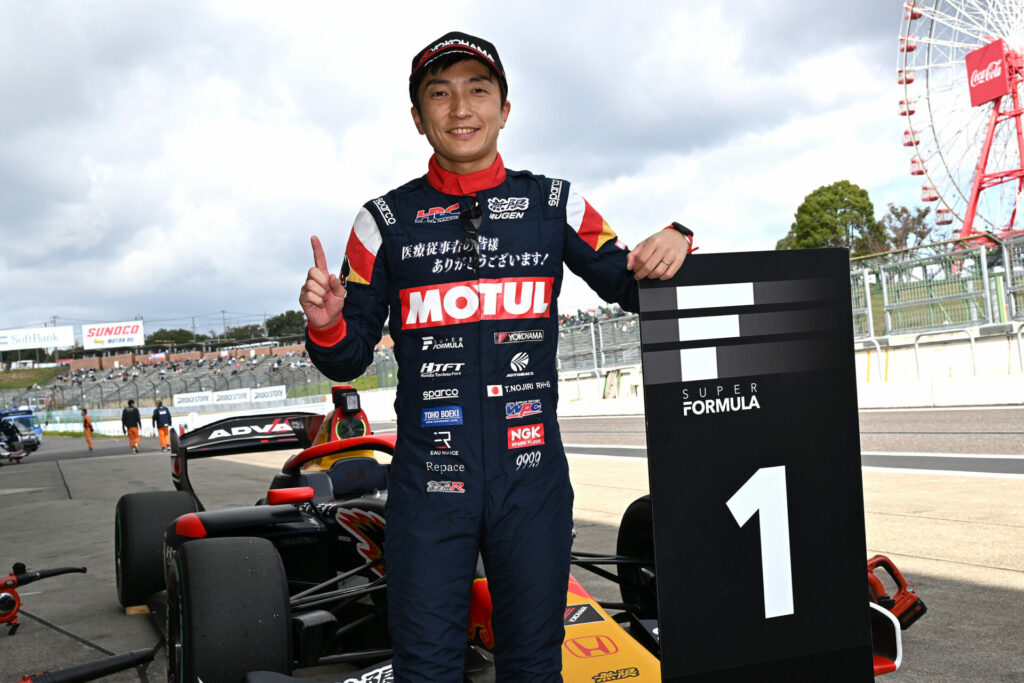
This makes for a tricky challenge for his latest rookie team-mate Iwasa, who’s spent the last four years training in Europe (French F4 > F3 > F2). I’ll repeat what I said of Liam Lawson a year ago: The most difficult challenge Iwasa faces will be in the garage across from his. But, with Mugen, it’s no stretch to say Iwasa at least is in a stronger environment to succeed at the start of the year than Theo Pourchaire is at Impul.
Iwasa was a genuine title contender early in F2 2023. And like Pourchaire, this move to Super Formula potentially represents his last chance to impress the Red Bull F1 superstructure and earn a promotion to “The Pinnacle”. He has all the speed and the skill, and he took little time at all getting to grips with the SF23. I just fear that anything short of winning the championship on debut will be enough for him to get that chance – given that Lawson’s great 2023 season still wasn’t enough for him not to be roadblocked by more tenured options.
That doesn’t mean Iwasa won’t be an exciting addition to the grid, and I’m eager to see how he matches up against the best driver in Super Formula. Likewise, I’m eager to see Nojiri take another run at a third series title that would put him in elite company. Team Mugen has some of the best engineering talent in its wings, headed up by two-time title-winning engineer Toshihiro Ichise who heads up Nojiri’s team, and the socially-active Tomohiko Koike who’s going to go from Lawson to Iwasa this year and won’t miss a beat.
This is the standard for which all other teams are measured. Can anyone reach it?
A special thanks to friend of the show, and trusted colleague, Jens “Geinou” Sobotta, as well as Jamie Klein, whose work covering Japanese single-seater racing can be found at the Japan Racing Insider newsletter.
Another longtime friend of M101, Jake Sanson, will be commentating the opening round of the season on the official Super Formula SFgo app – where all races will be streamed in English, and also simulcast on Motorsport.tv.
I’d also like to recommend Tōru Kitajima’s website, Japanese Racing Records, a near-complete and detailed archive of every season of Japanese Top Formula Racing. Kitajima has even written a massive 477-page book that chronicles the first 50 years of the series’ history!
All photographs © JRP
